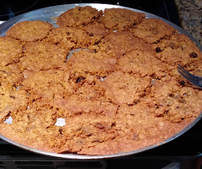Honey Series: How is honey made?
8/17/2017
Honey has a history as old as time symbolizing abundance and power. In fact, the promise land that God had for the Israelites was described as a land flowing with milk and honey. The bee has also been used as an emblem of power. The Egyptians used the bee to symbolize royalty and was the sign of the king of Lower Egypt during the First Dynasty (3,200 BC), and Napoleon’s robe was embroidered with bees.
We cannot know for a fact how long honey has been in existence, but cave paintings from 7000 BC in Spain show records of beekeeping. As one can imagine, honey has taken many forms of use throughout its history. For example, honey was used to develop an alcoholic drink called Mead, which was considered to be the nectar of the gods. It was also used to make furniture polishes, varnishes and for medicinal purpose, just to name a few. But after discovering all its benefits and uses, one can’t help but wonder, how is honey made? Honey is produced by worker bees, which are the smallest bees in the colony and are non-reproducing females. Bee experts state that it takes 60,000 honeybees traveling to about 2 million flowers (55,000 miles) to make 1 pound of honey. Therefore, an average worker bee will make only one-twelfth of a teaspoon of honey in its lifetime. Bees have two stomachs - one for eating and another to store the nectar collected from flowers. The bee regurgitates it into the honey comb until the nectar is partially digested. Then, the bees fan the liquid nectar to make it thicker and remove humidity. Finally, the bee seals the nectar with a liquid it secretes from its abdomen, which hardens the nectar into beeswax. Beekeepers then go into the hive collecting the honeycomb frames and scrape off the wax that the bee made to seal off the honey. Then, they place these frames in a centrifuge that spins the frame to take out the honey from the comb. After the honey is extracted, it’s strained to remove any remaining wax, bottled and labeled, and sent to market for you to consume. With such a lengthy process and effort, it’s no wonder that the bee has won the admiration of so many throughout its history.
0 Comments
 Hello!! We're so excited to launch our new page and get to hear from you. My name is Camila and as the sidebar notes, I'm a millennial who loves food and I'm learning to cook. This blog will chronicle this learning process and would truly appreciate your feedback and any help when I fail miserably, such as when I tried to make oatmeal cookies and they came out looking like some deformed pie crust... I'll be posting bi-weekly recipes from family, friends and the world wide webs that I find are easy enough for a beginner like me to do. I'll also share health tips, and interesting finds on some of our products. But I'm interested in hearing from you, so send us your quick and easy recipes, tips and curious discoveries so we can feature you and help other people that are in the struggle of wanting to live a healthier lifestyle but don't always have the time! Stay tuned for our upcoming post or subscribe to our newsletter to get our posts sent directly to your inbox. |
About the authorMy name is Camila, and I curate recipes from the web, friends and family to share them with you! I love food but I'm learning to cook so I can keep enjoying this pleasure! Recipes featuring you
How do you use our Yummmy products? We'd love to know how you create delicious recipes with our products. Send us your recipes for a chance to be featured in our site! |

